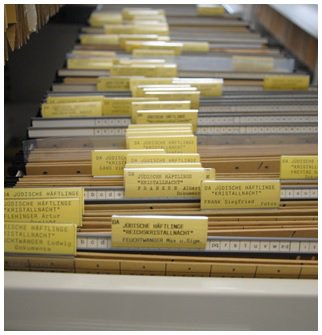News from the Archive – Newsletter 8 – 2017
News from the Archive
The Archive and
the collection at the Memorial Site got their start from an initiative of the
survivors of Dachau concentration camp, who collected material for an
exhibition in the former maintenance building in the late 1950s. In the
process, contact and communication with their former comrades was of key
importance. Their work is not only the foundation of our collection on the
history of Dachau concentration camp, but also on the history of the Memorial
Site.
Digitization project in 2016
Thanks to a
project embracing all memorial sites and financed by the German Federal
Commissioner for Culture and Media, it was possible last year to digitize more
than 30,000 pages from the legacies of former inmates and inmate organizations.
This marks a big first step on the way to securing this material for the long
term and making it accessible. Follow-up projects are needed to digitize more
of the inventory.
 New finding aid
New finding aid
Finding
aids and databases are the most important tools for using the Archive. An
overview of the Memorial Site’s inventories is provided by the finding aid that
will also be accessible to Archive visitors in the future. After a two-year
project phase, the inventory of written documents and the photo collection of
the Archive, which take up an area of about 250 meters, were screened and their
contents summarized in a 350-page book. The finding aid is arranged by topic
and has the same structure as the Archive. Along with files on individual
persons, which were compiled according to the core themes of “inmate
nationalities”; “inmate categories”, “subcamps”, and “work details”, the
materials on medical care, for instance, or on medical experiments, rations,
personnel matters, cultural activities, and “protective custody documents”
provide a glimpse of daily life at Dachau concentration camp. The inventories
on the camp SS, the Dachau Trials, and the history of the Memorial Site are
still in preparation.
Thanks to the finding aid, visitors as well as
the staff of the Memorial Site can quickly and comprehensively grasp the
thematic structure of the Archive, as well as its specific inventories. It describes the contents of the files, references
the origin and term of the material, and indicates its scope and location.
Users also learn whether the archived material is available in its original
form or as a copy. The finding aid is a significant addition to the Archive
database and facilitates scientific work.
Survivors, relates, and
their “treasures”
Even in 2017, communication with
the survivors of Dachau concentration camp and their relatives is still
tremendously important to the further expansion of the Archive and collections.
The number of inquiries reaching the Archive is
constantly increasing. There were nearly 1,700 in 2016, most of which came from
relatives of former inmates. Among these last year was a young schoolgirl who
is a sixth-generation descendant of one of the former inmates from the initial
stages of Dachau concentration camp. Descendants often know little or nothing
about their relatives. In many cases, relics from time spent in a concentration
camp are handed down carefully from generation to generation and finally lead
to an inquiry with the Memorial Site. Again and again, families are ready to
gift material on their relatives to the Archive, usually as scans or copies,
but sometimes even the originals. One major goal of the Memorial Site’s
collecting activities is to be able to present the former inmates of Dachau
concentration camp and its subcamps in all their variety and uniqueness, and in
this way to reveal the human beings behind the SS “numbers”. Some of these “new
additions” in 2017 are presented here by way of example:
New acquisitions
Notebook of Édouard
Froidure (1899−1971)
Belgian survivor Édouard
Froidure, a clergyman from Brussels, noted down the names, dates of birth and
death, as well as the addresses of Belgians who died at Dachau concentration
camp. We can assume that he wanted to make contact later with their relatives.
This list of names, as well as the other things he jotted down in his notebook,
were important pieces of evidence for the survivors. They wanted to use them to
record the crimes perpetrated at Dachau concentration camp and establish a
system of information. We thank the Secretary General of the Comité
International de Dachau (CID), Roger de Taevernier, for handing over this
document to the Memorial Site’s Archive.
Drawings by
Michał Porulski (geb. 1910− date of death unknown)
The Memorial Site acquired
original drawings by the trained draftsman and Dachau survivor Michał Porulski
from the estate of the Polish Dachau inmate Aleksander Wojno (1901−1999). The
six drawings handed down to us forcefully illustrate the inhuman working
conditions and especially the brutal behavior of the guards when enforcing camp
punishments. Porulski, who stayed at Dachau for a time after the liberation,
also crafted the so-called Dachau Album, now in the possession of the daughter
of a Jewish survivor.
Photos: © KZ-Gedenkstätte Dachau
